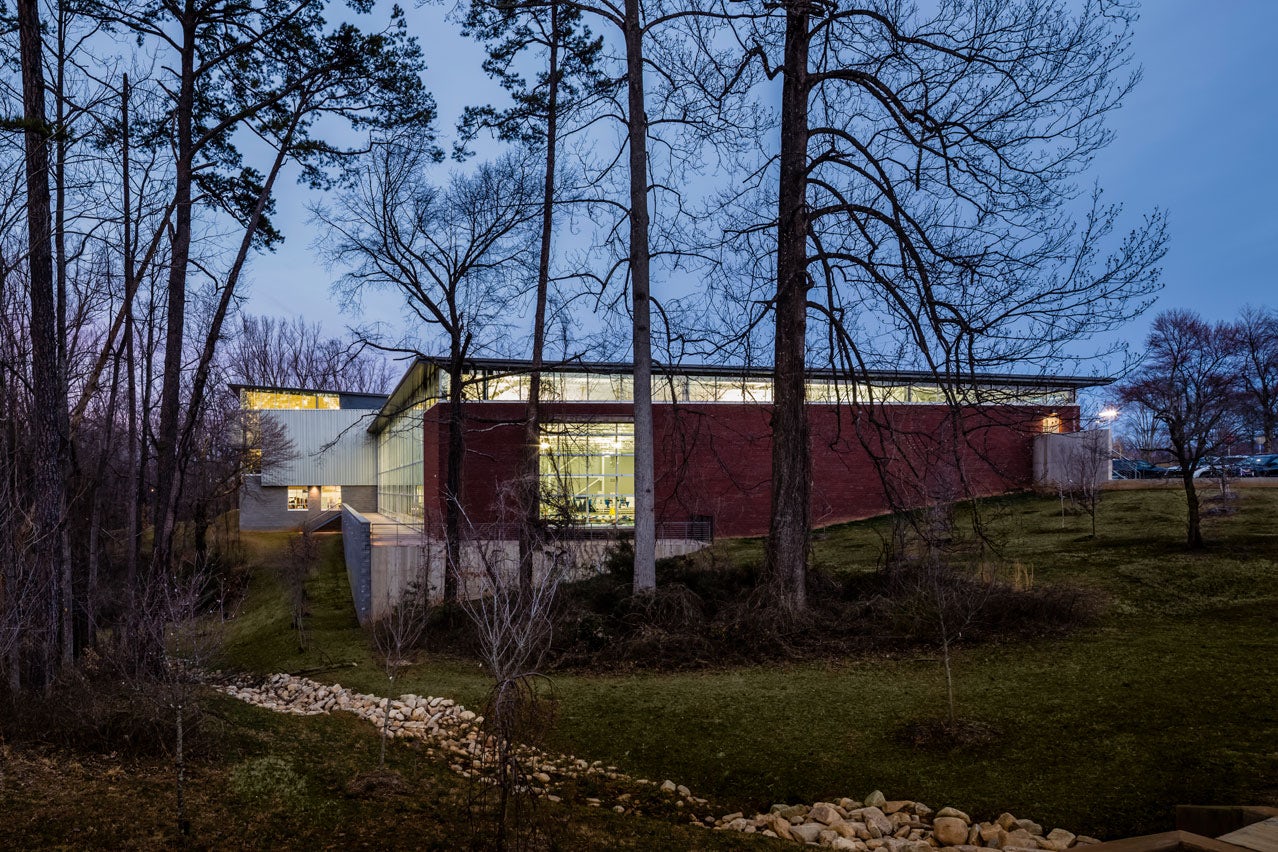Since 2016, we’ve adopted a “one firm, three studios” approach that emphasizes overlaps and collaborations between our 3 studios (K12, Higher Ed, Athletics + Community). These collaborations – which contribute to advancements in our design work, research efforts, sustainability advocacy, pro bono commitments, technical knowledge sharing, and business practices – reinforce a singular firm-wide belief that Architecture is the bridge that connects people and place. In order to bring this approach to life, design is underway on a new web portal that defines our commitments to architecture through the lens of seven core values. Below, we reflect on how we’ve brought these values to life in 2018 and plan to continue to build on them in 2019 and beyond.

Small Size, Big Impact
While small in size at 70 people and located outside major metropolitan hubs in Charlottesville, VMDO has achieved accolades for its designs of learning environments on par with large multinational firms. In 2018, Discovery Elementary School became the first verified Zero Energy (ZE) building certified by the collaborative partnership of the International Living Future Institute (ILFI) and New Buildings Institute (NBI). According to both the ILFI and NBI, Discovery is currently the largest verified ZE building of any kind, anywhere in the world. The project earned VMDO’s second AIA Committee on the Environment (COTE) award and was named a Green Ribbon School from the U.S. Department of Education. VMDO’s achievements in sustainable design were recently recognized by Architect Magazine, who ranked VMDO #32 for Sustainability in its annual Architect 50 publication.

Inspiring Change through ZE Design
Discovery Elementary School continues to inspire change at local, state, and national levels since its opening. At the local level, Arlington Public Schools has made net-zero energy a requirement for the procurement of new construction. At the state level, the leaders of the aforementioned policy successfully lobbied the Virginia Assembly to pass legislation that allows net-positive schools to sell and keep the funds generated from this excess energy. At the national level, the U.S. Department of Energy launched the Net-Zero Accelerator at Discovery – a national partnership aimed at demonstrating how investing in renewable energy translates into cost savings and enhanced learning environments. The lessons learned from Discovery are being translated into the firm’s next generation of schools, like Bluestone Elementary School, Fleet Elementary School, and Reed Elementary School, which are all planned to be net-zero ready and achieve even better energy targets than Discovery.

Evidence-Based Design
Not only are VMDO’s designs setting the bar with building performance, but they are also joyful, healthy places that nourish learning, growth, and student development. The firm earnestly believes that places of learning should be expressive of a community’s highest ideals and represent those aims tangibly through environmentally sensitive designs that befit a community’s context, enduring traditions, and goals for future generations. Mirroring these external hopes internally, VMDO continues its tradition as a teaching firm that helps employees as well as clients and students question and (re)define the role of architecture in society – and become creative participants in future solutions.
Grounding these aspirations in evidence-based research and interdisciplinary design dialogue has been an ongoing priority. Working with a team of public health researchers, pediatricians, social scientists, and educators, the Healthy Eating and Physical Activity Design Guidelines for School Architecture – published by the CDC and PLOS ONE, respectively – continue to find wide application as replicable planning tools for schools and contribute to new research. Currently in development are design guidelines for early childhood learning environments, which until now have lacked support from financial and pedagogical frameworks despite research demonstrating their return on investment and contribution to economic, emotional, professional, and social quality of life.
All three of VMDO’s studios (K12, Higher Education, and Athletics + Community) are working at the leading edge of design and health to support quality human-scaled architecture. In the higher education studio, VMDO, with the University of Virginia (UVA), is piloting the Integrative Process for Health Promotion (IPHP) LEED credit as part of the design of a new Student Health and Wellness Center. Through the development of methodologies, forums, and workshops generating dialogue around how buildings can facilitate health and improve access to healthcare, VMDO and UVA hope to develop a framework that can inform health-focused and health-promotional design processes for all projects at UVA moving forward. Building on the research methodologies set up to support the development of the healthy eating and physical activity design guidelines, this IPHP pilot credit is also informing work on other campuses, including the University of Richmond and the University of Miami.

Creating Community at All Scales
From our research collaborations, we know the two major health risk factors facing today’s students are high levels of anxiety/depression and social isolation, and that an antidote to these factors are feelings of belonging and connectedness. Thus, the importance of creating a sense of community in our work cannot be overstated.
We have been exploring strategies to create a sense of belonging across scales and building types. In the past year, our work on Georgia Tech's Glenn and Towers Halls, Clemson University's Core Campus Complex, Charlottesville’s Brooks Family YMCA, and Liberty University's School of Music + Concert Hall were recognized with AIA state awards and, in the case of the Georgia Tech project, with a 2018 SCUP award for planning and design. These projects explore different ways of creating community between rooms, within floors, and between buildings, and build on decades of post-occupancy evaluations (POEs) from user groups to inform design decisions. Recent POE research from Clemson reveals statistically significant areas of impact where students' experiences living in Core Campus’ Honors College are directly tied to feelings of community, belonging, and identity.

Planning for the Future of Learning
Campuses can also help to unify and deepen a sense of belonging, both to a larger human community and to each unique place, history, and institution. Our work for Virginia Wesleyan University on the Greer Environmental Sciences Center, a 2018 SCUP award recipient for planning and design, not only created a new home and identity for VWU’s emerging environmental sciences program, but it also revitalized the campus by finishing the main quad and providing a gateway to the honors residential village. The reintroduction of constructed wetlands and rain gardens in that project brought previously remote research directly into the heart of campus and reconnected the campus ecosystem to the larger Chesapeake Bay watershed.
In our K-12 work, we focus on creating distinct learning neighborhoods that are flexible enough to allow students to be agile and independent while experiencing the benefits of learning in a shared environment. This sense of community is reinforced through visual connections between spaces and the outdoors, as well as with place-based environmental graphics and wayfinding that empower students to become stewards of their school and feel connected to the larger world around them.

Commitment to Timeless Design
As a teaching practice focused on design quality, we have an unwavering commitment to architecture as a craft. For us, this means not only developing beautiful detailing, but also delivering buildings and campuses that can be easily maintained by their owners, that fluidly adapt to ever-changing needs and desires, and that grow more beautiful over time. It means investing in the quality of our documentation and the lasting relationships with the people that build and run our buildings. It includes the care with which we steward project budgets, community investment, and stakeholder engagement. Our commitment to craft means we are constantly looking to expand our knowledge about how to make our buildings better and sharing those lessons both within and outside the firm.

Commitment to Advocacy
Finally, we recognize the importance of giving back to the place and community that we live and work in through service to our immediate AIA chapters – Central Virginia and Virginia – and through contributions, mentorship, and advocacy for nonprofits and local community organizations. This year, we delivered testimony on how to responsibly design safe and secure schools to the Virginia House Select Committee on School Safety that were translated into recommendations that are on the agenda for the 2019 Virginia Assembly. While buildings cannot prevent violence, they can – through a balance of physical and programmatic hardening and softening strategies – responsibly contribute to a sense of belonging, identity, and psychological security within a larger culture. Beyond good design theories and practices, it takes a holistic mix of industries and services – bolstered by awareness, advocacy, and investment – to advance commitments to mental health services and school resources
In addition to reporting on the 2030 Commitment, we are signatories of two recent AIA COTE advocacy initiatives calling for a stronger emphasis on the need to address climate change. We are also signatories of Architects Advocate and are participating in the JustDesign initiative to promote best practices related to hiring and firm management. We are also in the process of undergoing ILFI’s JUST certification as a way of improving our firm management through a social justice lens.
As a one-office, regional firm with a singular focus on learning and community, it is of utmost importance to demonstrate our commitments to our local community and weave that dedication into our service to the region and larger architectural world. We are proud to design high quality regional work that exemplifies the power of architecture to respond with care and nuance to the larger issues facing our and future generations, and to promote health and wellness of people and ecosystems everywhere.

